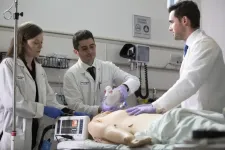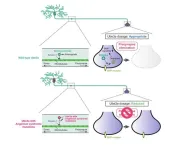(Press-News.org) NEW YORK, NY, Sept. 14, 2023--A study led by Columbia obstetricians has shown that a new intrauterine device can rapidly control postpartum hemorrhage, a major cause of severe maternal morbidity and death, in real-world situations.
“Our findings show that the device is an important new tool in managing postpartum bleeding,” says Dena Goffman, MD, professor of obstetrics and gynecology at Columbia University Vagelos College of Physicians and Surgeons and senior author of the study.
“We had previously shown that the device worked well with patients who were experiencing relatively minor bleeding, so it's really reassuring to see that the device worked almost as well among a wider range of patients and when used by many different doctors.”
Overall, the device succeeded in controlling hemorrhage in 93% of patients who delivered vaginally and 84% who delivered by cesarean. The results were published Sept. 14 in the journal Obstetrics & Gynecology.
Postpartum hemorrhage is a major cause of severe maternal morbidity and death
Shortly after birth and delivery of the placenta, the uterus contracts and closes off the blood vessels that nourished the placenta. Failure of the uterus to contract after delivery can result in prolonged and excessive blood loss, which may necessitate blood transfusions, ICU admission, or surgery to try to stop the bleeding and, if needed, removal of the uterus.
"Less than 10% of people who give birth will have excessive postpartum bleeding, but when it happens, it can get really serious really fast,” says Goffman, who co-authored the most recent guidelines from the American College of Obstetrics and Gynecology for the treatment of postpartum hemorrhage.
In the United States, 12% of maternal deaths are attributed to postpartum hemorrhage.
Current treatment options not ideal for all patients
To stop excessive bleeding, clinicians usually start by manually stimulating the uterus and giving medications that help the uterus contract, but some of these drugs are not safe for patients with hypertension or asthma. When medication fails or isn’t an option, patients may be treated with a balloon-like tamponade device that is inserted into the uterus and controls bleeding by placing pressure on the uterine wall.
Balloon tamponade devices have a high success rate, but this treatment has an impact on the patient and family experience. “The balloon often stays in the uterus for 12 to 24 hours until the uterus is well-contracted, and during that time the patient can’t sit up in bed, can’t walk around, can’t easily care for the baby,” Goffman says.
New device approved in 2020
In 2020, the FDA approved a new intrauterine device to control postpartum bleeding that uses low-level suction to promote uterine contractions.
“With postpartum hemorrhage being one of the most preventable causes of maternal morbidity and mortality, practice-changing innovation was needed to better equip our teams and care for our patients,” says Mary D’Alton, MD, chair of the Department of Obstetrics & Gynecology at Columbia University Vagelos College of Physicians and Surgeons and national leader of the clinical trial that first tested the safety and efficacy of the device.
In that initial trial, which led to FDA approval, the device controlled bleeding in a median of 3 minutes among 106 patients experiencing relatively minor blood loss after childbirth and was removed about 3 hours after insertion. Most patients in the trial delivered vaginally. The trial also excluded patients with preterm births <34 weeks.
New study shows device is highly effective when used in real-world conditions
The current study, which included more than 800 patients giving birth at 16 hospitals, was designed to study the effectiveness of the new device when used outside of a tightly controlled clinical trial setting. One third of the patients in the new study had a cesarean, and 50 patients had a preterm birth <34 weeks.
Median blood loss volume before device insertion was also higher in the new study, reflecting a greater range in blood loss, with some patients losing substantial amounts of blood (up to 3,000 mL). Most patients had been treated with medications to manage postpartum bleeding prior to device insertion.
Treatment with the new device was successful in 93% of patients who had a vaginal birth and 84% of patients who had a cesarean birth (similar to efficacy with intrauterine balloon devices). The device brought bleeding under control within 5 minutes or less for most patients. Treatment success rates were higher in patients with less blood loss prior to device insertion.
What’s next
The researchers say that early recognition of postpartum hemorrhage and timely intervention are crucial in managing the condition and preventing potentially life-threatening complications.
“Postpartum hemorrhage is a treatable condition,” Goffman says. “Delivery teams need to be attuned to recognizing it quickly and managing it in a seamless and sequential manner before a patient experiences significant blood loss.”
Additional studies comparing the new device with other treatments for postpartum hemorrhage are being planned to determine if using the device earlier produces better outcomes.
“Until we have more data, we’re using the new intrauterine device after medications have been tried,” Goffman says. “But for patients with underlying conditions who cannot be treated with one or more of our available medications, the device is a critically important tool to have.”
More information
Dena Goffman, MD, is the Ellen Jacobson Levine and Eugene Jacobson Professor of Women’s Health (in Obstetrics &Gynecology) at Columbia University Vagelos College of Physicians and Surgeons.
The article, titled "Real-World Utilization of an Intrauterine, Vacuum-Induced, Hemorrhage-Control Device,” was published online September 14.
All authors: Dena Goffman (Columbia University Irving Medical Center, New York, NY), Kara Rood (Ohio State University Wexner Medical Center, Columbus, OH), Angela Bianco (Mount Sinai Icahn School of Medicine, New York, NY), Joseph Biggio (Ochsner Health, New Orleans, LA), Paul Dietz (West Virginia University School of Medicine, Charleston, WV), Kelly Drake (Abbott Northwestern Hospital, Minneapolis, MN), Erica Heilman (ChristianaCare Health System, Newark, DE), Maeve Hopkins (University Hospitals, Cleveland, OH), Monique De Four Jones (Long Island Jewish Medical Center, New Hyde Park, NY), Tyler Katz (University Hospitals), Courtney Martin (Loma Linda University Children’s Hospital, Loma Linda, CA), Mona Prasad (Ohio State), Marcela Smid (University of Utah Health, Salt Lake City, UT), Kathryn Wine (Alydia Health, Menlo Park, CA), Robert Ryan (Organon, Jersey City, NJ), Patricia Carney (ChristinanaCare), and Hyagriv Simhan (Pittsburgh Medical Center, Pittsburgh, PA).The study was funded by Alydia Health Inc. and Organon & Co.
Disclosures are listed in the study.
END
New device rapidly controls postpartum hemorrhage
2023-09-14
ELSE PRESS RELEASES FROM THIS DATE:
Grant funds study of video game for preventing unintended teen pregnancies
2023-09-14
Weill Cornell Medicine has been awarded a five-year, $5 million grant from the United States Department of Health and Human Services through the Office of Population Affairs under the Teen Pregnancy Prevention Program to conduct a randomized trial testing whether a bilingual video game called “No Baby No (No Bebé No)” can increase the use of contraception among sexually active Black and Hispanic adolescents.
“Nine out of ten teens play video games. No Baby No empowers Black and Hispanic adolescents to learn about contraception, and the potential consequences of not using it, in a risk-free virtual ...
New evidence indicates patients recall death experiences after cardiac arrest
2023-09-14
Philadelphia, September 14, 2023 – Up to an hour after their hearts had stopped, some patients revived by cardiopulmonary resuscitation (CPR) had clear memories afterward of experiencing death and had brain patterns while unconscious linked to thought and memory, report investigators in the journal Resuscitation, published by Elsevier.
In a study led by researchers at NYU Grossman School of Medicine, in cooperation with 25 mostly US and British hospitals, some survivors of cardiac arrest described lucid death experiences that occurred while they were seemingly unconscious. Despite immediate treatment, fewer than 10% of the 567 patients studied, ...
Clinical whole genome sequencing test developed at JAX
2023-09-14
Until quite recently, it was extremely difficult to detect the variants underlying many genetic disorders. In the absence of a defined cause, clinicians have little to guide treatment for those left without a genetic diagnosis, forcing patients and families to embark on a diagnostic odyssey with no guarantee of finding answers.
A decade ago, sequencing centers began offering clinical whole exome sequencing, but these only cover the portion of the genome that codes for proteins – approximately 1.5 percent of the entire genome. While relatively successful, the diagnostic yield for most clinical exome sequencing programs is roughly 25 percent, leaving 75 percent of cases without ...
UCI researchers announce publication of an open-label clinical trial suggesting that N-acetylglucosamine restores neurological function in Multiple Sclerosis patients
2023-09-14
Irvine, CA – Sept. 14, 2023 – UCI researchers have found that a simple sugar, N-acetylglucosamine, reduces multiple inflammation and neurodegeneration markers in people who suffer from multiple sclerosis (MS). In addition, they also found this dietary supplement improved neurological function in 30% of patients.
According to the World Health Organization, MS affects more than 1.8 million people, and while there are treatments to prevent relapses and improve quality of life, there is no cure.
The study, N-acetylglucosamine ...
Vocal learning linked to problem solving skills and brain size
2023-09-14
The European starling boasts a remarkable repertoire. Versatile songbirds that learn warbles, whistles, calls, and songs throughout their lives, starlings rank among the most advanced avian vocal learners. Now a new study published in Science finds that starlings, along with other complex vocal learners, are also superior problem solvers.
“There is a long-standing hypothesis that only the most intelligent animals are capable of complex vocal learning,” says Jean-Nicolas Audet, a research ...
Study finds spiritual coping behaviors may be key to enhanced trauma recovery of Black men who survive firearm injury
2023-09-14
PHILADELPHIA (September 14, 2023) – High rates of firearm injury among urban Black men in the U.S. can lead to long physical and psychological recovery times, worsened by limited access to mental health services. In the face of firearm injury, urban Black men may feel they have lost control over their lives, leading to fear, paranoia, lack of forgiveness, and different dimensions of mental health challenges, which can be difficult to overcome.
In a pilot study from the University of Pennsylvania School of Nursing ...
In the “I” of the beholder: People believe self-relevant artwork is more beautiful
2023-09-14
People have fairly consistent preferences when it comes to judging the beauty of things in the real world—it’s well known, for example, that humans prefer symmetrical faces. But our feelings about art may be more personal, causing us to prefer art that speaks to our sense of self, research in Psychological Science suggests.
“When there is personal meaning in an image, that can dominate your aesthetic judgments way more than any image feature,” said Edward A. Vessel (The City College of New York) in an interview. Though self-relevant ...
Aspergillus fumigatus is a saprotrophic fungus that can cause serious life-threatening invasive infections in immunocompromised individuals
2023-09-14
Aspergillus fumigatus is a saprotrophic fungus that can cause serious life-threatening invasive infections in immunocompromised individuals; by constructing a recombination map, this study shows that A. fumigatus produces the highest number of crossovers per chromosome ever described (~30 per chromosome pair).
#####
In your coverage, please use this URL to provide access to the freely available paper in PLOS Biology: http://journals.plos.org/plosbiology/article?id=10.1371/journal.pbio.3002278
Article Title: The human fungal pathogen Aspergillus fumigatus can produce ...
During failure of core protein quality control in the nematode C. elegans, a specialized anti-aggregation mechanism relying on pathogen response factors and lysosomal mediated degradation is triggered
2023-09-14
During failure of core protein quality control in the nematode C. elegans, a specialized anti-aggregation mechanism relying on pathogen response factors and lysosomal mediated degradation is triggered, promoting tissue-specific resilience to age-dependent protein aggregation and its proteotoxicity.
#####
In your coverage, please use this URL to provide access to the freely available paper in PLOS Biology: http://journals.plos.org/plosbiology/article?id=10.1371/journal.pbio.3002284
Article Title: A safety mechanism enables tissue-specific resistance to protein aggregation during aging in C. ...
How a molecule deletes neural chat might help treat Angelman syndrome
2023-09-14
Researchers from the University of Tokyo reveal how the presynaptic Ube3a E3 ligase, a causal factor in Angelman syndrome, eliminates neural chat. The study helps find a better drug target for the Angelman syndrome treatment.
Neurons chat through electrical signals, transmitting information via connection sites between neurons—the synapses. After birth, the number of synapses increases. During childhood, the brain starts to mature and removes many unnecessary synapses. But sometimes, the development of the nervous system goes awry, leading to developmental disorders.
Kotaro ...








